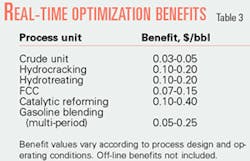Real-time optimization for refining
While the number of APC applications has increased continually towards a mature application period (with 5,000 worldwide applications), real-time optimization (RTO) applications have continued to develop in their formative years with 100 or so worldwide large-scale refining applications.
RTO systems are frequently layered on top of an APC system, producing economic benefits using highly detailed thermodynamic, kinetic, and process models, and nonlinear optimization.
Whereas an APC system typically pushes material and energy balances to increase feed and preferred products, RTO systems can trade yield, recovery, and efficiency among disparate pieces of equipment.
APC applications include process dynamics and RTO applications are typically based on steady-state estimates. RTO applications use detailed non-linear equipment and component models, which can use process measurements to characterize feed and other process streams.
Refiners frequently use RTO applications for offline studies because they provide a valuable resource for debottlenecking and evaluating changes in feed, catalyst, equipment configuration, operating modes, and chemical costs. The economic benefits identified in these studies can easily exceed those from online use.
Refining RTO has been hampered by the lack of reactor models for major refining units, property estimation techniques for petroleum streams, and the availability of equipment models. Continued technology advancement has removed many of these hurdles, however, and the number of reported RTO successes continues to grow (Table 3).
Refining RTO in the future will likely include wider applications driven by demonstrated benefits, reduced implementation costs, and acceptance as a best practice. RTO applications are also becoming tightly intertwined with refinery planning and scheduling systems, in which they can update models and calculate stream costs.
Evolving technologies changing the value proposition for refining RTO include:
- Detailed kinetic models for all major refining units and configurations, proven by reported applications.
- Optimization technology improvements that incorporate robust solvers, integer variables, and the capability to handle increasing problem sizes. Today's technology can handle applications with several hundred thousand equations; a typical refining application has 100 measurements, more than 100,000 variables, and 25 outputs.
- Greater integration with higher-level systems including shared models and reconciled measurement data.
- Multiunit optimization that leverages shared resources between process units and continues to lead towards rigorous refinery-wide optimization.
- Computing technology improvements, which have already shifted RTO from minicomputers to personal computers, and that will allow more solutions/day and more complex formulations. Solver and computing improvements will eventually lead to true dynamic optimization.
- Application and model building tools, operating graphical user interfaces, and sustained performance technologies that will lower cost, improve benefits, and remove other hurdles.

